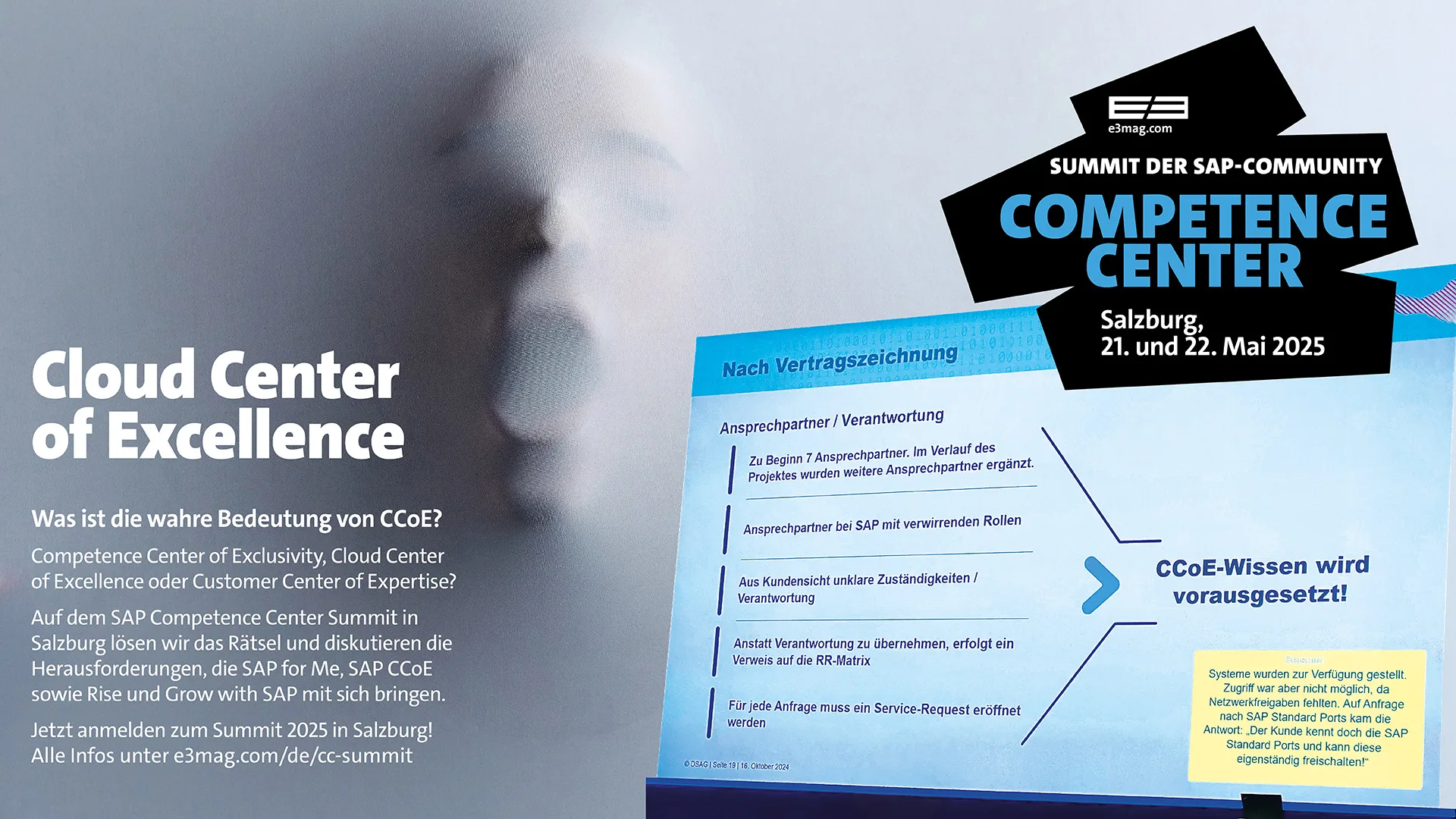Communication as a success factor
![[shutterstock.com:133114007, Markus Gann]](https://e3mag.com/wp-content/uploads/2017/02/shutterstock_133114007_CMYK.jpg.webp)

For some time now, the modern CIO has no longer been able to concentrate on evaluating purely technical issues. Business departments want and need agile solutions in order to be able to design processes optimally.
Many experts in specialist departments today have in-depth IT knowledge. Quite a few of them belong to the generation of digital natives who have already grown up with computers and smartphones.
Such "customers" have high demands on functional flexibility and, above all, on user-friendliness and intuitive operability of application systems.
Nor do they accept that IT experts are a bottleneck for designing business management solutions. Time is a decisive factor.
For the CIO, this development is ambivalent. On the one hand, you can rely on IT-savvy users and their expertise. The problem users of the past are very few and far between.
On the other hand, this competence also results in the tendency to create their own solutions. This results in isolated solutions and workarounds that should actually be a thing of the past.
In such a situation, it is difficult for the CIO to enforce a uniform and strategically oriented IT landscape based on harmonized and standardized processes.
Digitization is finally erasing the boundaries between business administration and IT. What was foreshadowed with the introduction of ERP systems in the 1990s and reinforced by the emergence of other systems (CRM, web stores, business intelligence, SRM, etc.) is now more than ever an everyday reality.
 In many companies, however, there is still a silo mentality: IT here - the business department there.
In many companies, however, there is still a silo mentality: IT here - the business department there.
This thinking often works along the lines of "Tell us what you need - we'll deliver." And it is precisely this pattern that is working less and less, because the business solution cannot be thought of without IT, and vice versa.
Like many difficult management tasks, reconciling all these requirements is like squaring the circle.
Communication skills, especially those of the CIO, are becoming a decisive factor.
This applies to personal communication on a 1:1 basis as well as to the communication of "the" IT into the entire organization.
Communication requires clarity and assertiveness. But you have to convince, involve, motivate and inspire people for your ideas much more than before.
There is no recipe for this. But there are basic attitudes and beliefs that are important in all situations: Respect, resistance processing, emotional communication and the external impulse.
Respect
Leadership trainer René Borbonus often talks about a very important topic, respect, in his talks and videos on YouTube.
In Wikipedia, respect is seen as appreciation, attention and deference to another living being. At René Borbonus you learn that respect always starts with perceiving and seeing the other person.
Without respect, he believes, even factually and technically correct positions will not prevail.
So before you get into what you want to say, it's first about seeing and understanding the other person, more precisely: the target group of my communication.
This involves gathering a lot of information about my employees and colleagues. Disrespect often results from problems that are only superficially "understandable," such as time pressure or the variety of tasks to be accomplished.
However, disrespect also results from a lack of awareness of how important successful communication is, especially for the assertion of clear positions.
Borbonus introduces in his YouTube video the example of Gordon Brown (former Prime Minister of Great Britain).
The latter made condescending remarks after a TV encounter with a woman, unaware that the microphones were inadvertently still on the air.
Although the woman had arguably not taken positions that would have won majority support, Brown became a target of criticism precisely because he had behaved disrespectfully.
A good example of how communication fails and the consequences it can have.
It is important for CIOs to not only recognize the importance of successful communication, but also to prioritize the design of that communication accordingly.
Resistors
Those who behave respectfully know their target group and know what is going on in people's minds. This also makes it possible to anticipate the resistance that accompanies every change and every further development.
Resistance is often complex and personal. Resistance is amplified in the communication between those affected.
In the Theory of Constraints, levels of resistance include the following:
- Lack of agreement on the problem: Affected people do not see the problem that the change is aimed at fixing or do not see it as significant.
- Lack of agreement regarding the responsibility of the problem (I am not responsible!)
- Lack of agreement on the solution. One sees the problem, but doubts that the solution is correct.
- Rejection of the solution because of the side effects (Yes, but...)
- Rejection of the solution because it does not appear to be feasible
- Solution is accepted, but you do nothing yourself first, but wait for others.
CIOs who base their communications on knowledge of the various levels of resistance are able to formulate factual messages that work.
Emotional communication
The factual core is an important basis for successful communication. However, this core is only a necessary, but not at the same time a sufficient condition for success in communication.
In addition, there must be an emotional component. This still comes up short in many companies today.
In CIO communications, it's important to sharpen the factual core of a message in an inspiring and gripping story without diluting or trivializing the point.
Those who approach communication respectfully, against a background of knowledge of the target group and possible resistance, will have an easy time pointing out positive aspects of a change - for the individual employees and the company as a whole.
Emotions are also created by a good atmosphere. Overcrowded meeting rooms with little oxygen have the opposite effect.
New workshop concepts such as BarCamps open up new possibilities here. These formats enable informal exchange at eye level, instead of hierarchical "top-down communication".
Direct exchange with those affected and variable processes (depending on the course of events) show that people are taken seriously. In this way, people can be won over to projects that they are actually critical of.
External pulse
Successful communication often also needs the view from the outside. The development of routines and standardized processes is an important strength of companies.
In communication, however, there is a danger of patterns emerging that miss their mark.
Important information must stand out from the routine in order to be noticed.
Outsiders often have a different view and see things that are no longer accessible to the person concerned. You could call that operational blindness. Or a lack of distance. Literally, you can no longer see the forest for the trees.
Outsiders can often see much more quickly what are really the key points that matter.
Of course, the outsider also needs a trained eye and must intuitively approach and work on a topic for as long as is necessary for a good understanding.
Many readers will point out that there are exceptional charismatic leaders. There are also executives who, due to temperament and personality, are more inclined to people than others.
Such types also find it easier to communicate. But communication in a company must never depend on this. Independent outsiders have their most important function here.
Interdisciplinary teams (consultants, psychologists, creatives, change managers) in particular can provide invaluable services at this point. They broaden management's perception, so to speak, and give the individual manager the necessary empathy.
In such creative teams, "broad" approaches to communication emerge that reach a large part of the workforce.
Conclusion
Today, CIOs are always caught between business requirements, the implementation of a future-oriented IT landscape and the people affected by both aspects.
Communication becomes the key factor. Respect means seeing and valuing the people involved. Respect is thus an important prerequisite for successful communication.
Those who are respectful recognize resistance and can develop the necessary factual messages based on this. Anyone who can convey these in a good atmosphere will succeed in generating enthusiasm.









